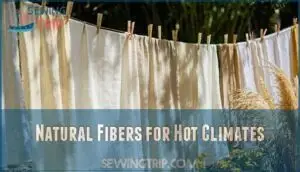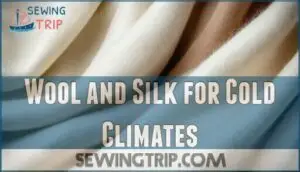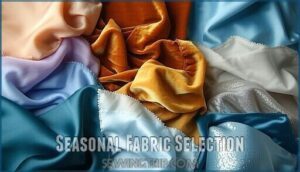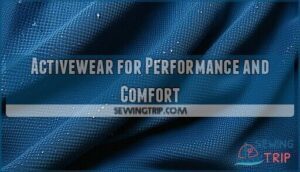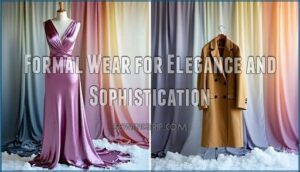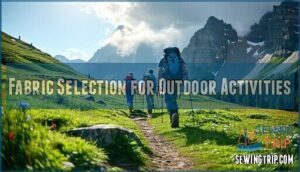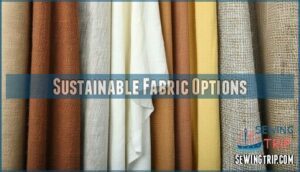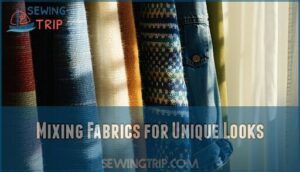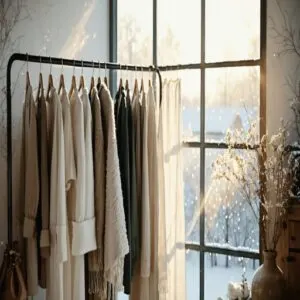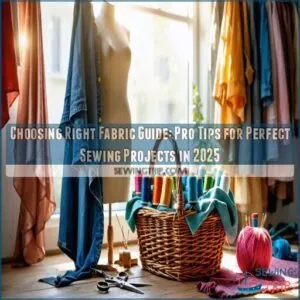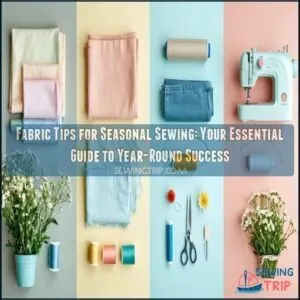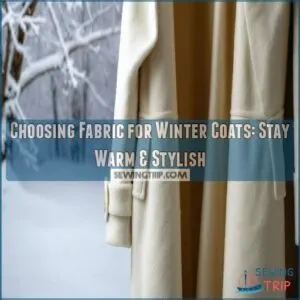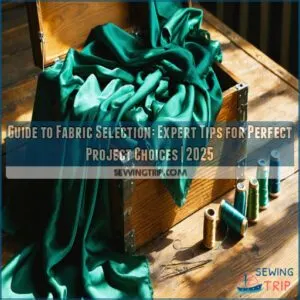This site is supported by our readers. We may earn a commission, at no cost to you, if you purchase through links.
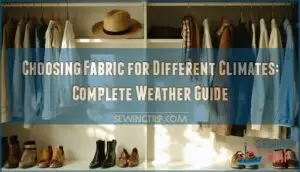
In hot places, reach for breathable cotton or linen to keep cool.
Humid days call for moisture-wicking synthetics—no one likes feeling sticky.
For chilly weather, wool’s your best friend, trapping warmth like a cozy blanket.
If the sun’s blazing, tightly-woven or UV-protective fabrics help guard your skin.
It’s all about matching your clothes to your environment, like picking the right tool for the job.
Want to know which fabric stands up to wild temperature swings or sudden rain?
There’s more to uncover ahead, including how to choose the right fabric for your specific needs, making it a personal weather choice.
Table Of Contents
Key Takeaways
- Pick breathable fabrics like cotton or linen for hot weather, and moisture-wicking synthetics for humid days to stay cool and dry.
- Choose wool or fleece for cold climates—they trap warmth and manage moisture, especially when layered with a wicking base.
- Go for tightly-woven or UV-protective fabrics when the sun’s strong to guard your skin without overheating.
- Mix natural and synthetic fibers for versatile, year-round comfort, and always match your fabric choice to your activity and local climate.
Fabric Properties Matter
When you’re choosing fabrics for different climates, understanding key properties like breathability, moisture-wicking, and insulation can make the difference between comfort and misery.
The right fabric choice is your secret weapon for staying comfortable, no matter what the weather throws at you.
Smart fabric selection isn’t just about looking good—it’s about staying cool in Miami’s humidity or warm during Chicago’s winter winds, which requires an understanding of insulation.
Breathability in Warm Climates
When temperatures rise, breathable fabrics become your best friend for staying cool.
Natural fibers like cotton and linen shine in hot climates through their open fiber structure and loose weave density.
These summer clothing materials excel at air permeability, allowing heat to escape while promoting moisture absorption.
The result? Superior fabric breathability that enhances your comfort perception during sweltering days.
For activewear, consider options that offer efficient moisture-wicking.
Choose lightweight, loose-weave options for maximum cooling power.
Moisture-Wicking in Humid Environments
When humidity turns the air thick as soup, moisture-wicking fabrics become your best friend for staying comfortable and dry.
These smart textiles pull sweat away from your skin through specialized wicking mechanisms, creating better fabric performance in sticky weather.
The right moisture management keeps you cool while preventing that clammy feeling.
- Polyester blends: Excel at sweat management with fast drying speed
- Microfiber fabrics: Soft textures with excellent comfort factors
- Bamboo textiles: Natural odor control plus breathable properties
- Nylon activewear: Superior moisturewicking fabric for humid climates
Insulation in Cold Climates
Cold weather calls for smart insulation materials like wool and fleece that excel at heat retention.
Wool’s natural fibers trap warm air while wicking moisture away from your skin.
Fabric density plays a key role too—tighter weaves create better thermal insulation.
For effective cold weather layering, combine warm fabrics with moisture-wicking base layers.
This creates winter comfort that keeps you cozy without overheating.
UV Protection in Sunny Climates
While insulation keeps you warm, UV protection becomes your shield when temperatures soar.
Sunscreen clothing with UPF ratings blocks harmful rays more effectively than regular fabrics. Fabric weave density matters—tighter weaves offer better protection.
Here’s your sun-smart fabric checklist:
- Choose UV resistant fabrics with UPF 30+ ratings
- Pick darker colors that absorb rays instead of reflecting them onto skin
- Select protective dyes that enhance sunlight reflection capabilities
- Layer lightweight options for maximum climate adaptation without overheating
Climate-Specific Fabrics
Different climates demand different fabric choices to keep you comfortable and protected throughout the year.
Understanding which materials work best in specific weather conditions helps you build a wardrobe that performs well whether you’re facing scorching heat, sticky humidity, bitter cold, or intense sun.
Natural Fibers for Hot Climates
When blazing heat hits, natural fibers work like personal air conditioners.
Cotton absorbs moisture while staying breathable, making it perfect fabric for summer wear.
Linen offers superior airflow and gets softer with each wash.
Rayon drapes beautifully and feels cool against skin.
Bamboo clothing provides natural antibacterial properties while silk options add luxury without trapping heat.
These natural fabrics beat synthetic alternatives every time.
Synthetic Fibers for Humid Climates
While natural fibers excel in hot climates, synthetic fibers dominate humid environments where moisture wicking properties become your best friend.
These high-tech materials don’t just handle sweat—they actively fight it.
Modern polyester and nylon fabrics feature engineered weave density that pulls moisture away from skin faster than you can say "sticky situation."
Quick drying technology means you’ll spend less time feeling like a soggy sandwich and more time comfortable.
One key advantage of these materials is that they’re durable and versatile.
- Polyester benefits include quick-drying properties and excellent durability
- Nylon properties feature lightweight construction and impressive strength
- Acrylic advantages include softness similar to wool without the weight
Microfiber performance shines through anti-microbial treatments for odor control.
Blends/combinations of synthetic fibers create breathability that keeps you fresh when humidity tries to drag you down.
Wool and Silk for Cold Climates
When winter winds bite, you’ll want wool and silk as your trusty companions.
Wool insulation traps air in its natural crimp, keeping you warm even when damp. Silk breathability adds lightweight warmth without bulk, perfect for layering options beneath heavier garments.
These natural thermal fabrics excel at cold-weather comfort through superior fabric weight distribution and moisture management. Wool’s fibers provide natural insulation properties, effectively trapping warm air.
Tightly-Woven Fabrics for UV Protection
When you’re facing blazing sunshine, weave density becomes your best friend.
Tightly-woven fabrics create a protective barrier that blocks harmful rays from reaching your skin.
The tighter the weave, the better your sun protection.
Look for UV resistant fabrics with UPF ratings of 30 or higher.
These specially designed textiles offer serious UV protection without sacrificing comfort.
Dark colors boost your defense even more.
Smart material choice and thoughtful clothing design keep you cool while preventing sun damage.
You’ll stay comfortable under intense sun exposure when your fabric works as hard as you do.
Seasonal Fabric Selection
You’ll want different fabrics as the seasons change to stay comfortable year-round. Smart seasonal choices help you adapt to temperature swings while looking great and feeling your best.
Spring and Summer Fabric Choices
During spring’s arrival, choosing breathable fabrics makes all the difference in staying cool and comfortable.
Lightweight weaves and breathable blends work best for warmer weather. These summer textiles handle hot climates while keeping you dry and fresh.
Top fabric picks for warm weather:
- Cotton – Natural moisture-wicking fabrics that let your skin breathe
- Linen – Ultimate lightweight fabrics for maximum airflow
- Bamboo – Modern breathable fabrics with natural sun protection
Summer colors in these materials create stylish seasonal trends.
Autumn and Winter Fabric Choices
As warmer months fade, cold weather layering becomes your best friend.
Winter fabric weights make all the difference in staying comfortable.
Wool provides excellent insulation while letting your skin breathe naturally.
Fleece offers lightweight warmth that won’t weigh you down.
Cashmere brings luxury to chilly days with unmatched softness.
| Fabric Type | Best Feature |
|---|---|
| Merino Wool | Natural temperature regulation |
| Fleece | Quick-drying warmth |
| Cashmere | Ultra-soft comfort |
| Flannel | Cozy everyday wear |
| Down Fill | Maximum insulation |
Choose insulating fiber types that match your lifestyle and climate appropriate clothing needs for winter success.
Layering for Temperature Changes
Smart layering turns your wardrobe into a personal thermostat for changing weather conditions.
You’ll stay comfortable whether morning’s chilly or afternoon warms up.
Layering Benefits come from building adaptable outfits with these components:
- Base Layer Fabrics that wick moisture away from your skin
- Mid-layer Insulation using wool or fleece for warmth retention
- Outer Shell Protection with breathable fabrics for weather defense
- Removable pieces for quick temperature regulation adjustments
This climate-appropriate clothing system beats wearing one heavy jacket all day.
Consider breathable cotton options for base layers.
Fabric Weight and GSM
Understanding fabric weight through GSM explained helps you choose climate appropriate clothing like picking the right jacket for weather.
GSM measures fabric density in grams per square meter.
Lower numbers mean lighter, breathable materials.
Higher numbers indicate heavier, insulating fabrics.
Weight categories directly impact seasonal suitability, fabric drape, and sewing impact for your fabric selection.
| GSM Range | Weight Category | Best Climate Use |
|---|---|---|
| Under 150 | Lightweight | Hot summers |
| 150-300 | Medium weight | Spring/fall |
| 300+ | Heavyweight | Cold winters |
| 100-200 | Standard | Year-round basics |
Understanding fabric properties guarantees comfort across seasons.
Activity-Based Fabric Choices
Your lifestyle shapes your fabric needs just as much as the weather does.
Whether you’re hitting the gym, heading to the office, or exploring the great outdoors, the right fabric choice makes all the difference between comfort and misery.
The right fabric choice is crucial in these situations.
Activewear for Performance and Comfort
Performance synthetics like polyester and nylon blends excel in activewear because they pull sweat away from your body.
These moisture-wicking fabrics keep you dry during tough workouts.
Stretch fabrics with spandex give you freedom to move naturally.
Breathable fabrics with mesh panels prevent overheating.
Seamless construction reduces chafing while compression benefits support your muscles.
Modern performance textiles also feature odor control treatments that fight bacteria buildup.
You can find a variety of fabrics for activewear online.
This means you can push harder and stay comfortable longer during any activity.
Workwear for Durability and Practicality
Every workwear fabric choice affects your comfort and job performance throughout demanding days.
Your clothing needs to handle tough conditions while adapting to different climates and maintaining professional appearance.
- Canvas and denim provide exceptional fabric durability for high-wear environments
- Polyester-cotton blends offer breathable fabrics with superior wrinkle resistance
- Ripstop weaves prevent minor tears from becoming major wardrobe malfunctions
- Treated fabrics deliver stain resistance and easy maintenance for busy schedules
- Climate-appropriate clothing guarantees comfort whether you’re working indoors or facing outdoor elements
Smart fabric selection means choosing materials that meet safety standards while providing cost effectiveness.
Consider fabric strength properties for long-lasting wear.
The right workwear fabrics balance practical design with climate adaptation, keeping you comfortable and protected regardless of weather conditions.
Formal Wear for Elegance and Sophistication
Formal wear requires luxury fabrics that match your event’s demands.
Choose silk or linen blends for warm gatherings—they offer elegance with breathability.
Winter occasions call for structured wool that maintains fabric drape while providing warmth.
Consider color palettes and cultural influences when selecting event-specific fabrics.
Climate-conscious formalwear means you’ll look polished and feel comfortable throughout your special event.
Fabric Selection for Outdoor Activities
When you’re heading outdoors, hiking fabrics and camping materials need serious performance power.
Choose moisturewicking synthetics that pull sweat away from your skin while maintaining breathability needs. Look for water resistance without sacrificing airflow.
Durability factors matter most when scrambling over rocks or pushing through brush.
Breathable fabrics with UV protection keep you comfortable during long trail days.
Smart climate considerations mean selecting fabrics that adapt to changing weather conditions throughout your adventure.
Sustainable Fabric Options
You can make smart fabric choices that benefit both your comfort and the planet.
Today’s sustainable options like organic cotton, bamboo, and recycled polyester offer excellent climate performance while reducing environmental impact.
Eco-Friendly Fibers Like Organic Cotton
Organic cotton sets the gold standard for eco-friendly fabrics that don’t compromise on comfort or performance. When you choose organic cotton, you’re supporting sustainable farming practices while getting all the breathability and softness you love about natural fabrics.
The difference lies in how it’s grown. Organic Cotton Farming eliminates harmful pesticides and synthetic fertilizers that pollute waterways and harm farmers’ health. This approach dramatically reduces Water Consumption compared to conventional methods while preventing Soil Degradation that weakens farmland over time.
Here’s what makes organic cotton a smart choice for your wardrobe:
- Zero Cotton Pesticide Use protects both farmers and ecosystems from toxic chemicals
- Lower water requirements make it more environmentally responsible than regular cotton
- Fair Trade Cotton options guarantee farmers receive living wages for their work
- Natural breathability keeps you cool in warm climates without synthetic treatments
These ecofriendly fibers prove that sustainable fabrics can deliver the same comfort and durability you expect from conventional materials.
Bamboo and Hemp for Sustainable Fashion
Bamboo and hemp offer impressive alternatives to traditional fabrics.
Bamboo softness rivals silk while providing excellent moisture-wicking for hot climates.
Hemp durability makes it perfect for workwear that lasts decades.
Both require minimal water and chemicals during sustainable sourcing.
Ethical production methods guarantee fair labor practices.
These natural fibers work brilliantly in fashion applications from casual tees to formal wear.
| Feature | Bamboo | Hemp |
|---|---|---|
| Climate Suitability | Hot/humid conditions | All-weather versatility |
| Texture | Silky and smooth | Sturdy but softens over time |
| Durability | Moderate strength | Exceptional longevity |
| Growth Requirements | Fast-growing grass | Minimal water/pesticides |
| Best Uses | Activewear, undergarments | Workwear, casual clothing |
These sustainable fabrics and ecofriendly fabrics represent the future of conscious fashion choices.
Recycled Materials for Reduced Waste
Recycled materials turn fashion waste into wardrobe treasures.
Recycled polyester transforms plastic bottles into durable clothing, while recycled cotton gives textile scraps new life.
These sustainable textiles slash fabric waste through closed-loop systems that continuously reuse materials.
Textile recycling creates eco-friendly fabrics with minimal environmental impact.
You’re building a sustainable wardrobe that fights waste while maintaining the performance you need for any climate.
Many brands are now pursuing GOTS certification to guarantee ethical production.
Environmental Impact of Fabric Production
Understanding fabric production’s environmental burden helps you make smarter wardrobe choices.
The textile industry consumes nearly 800 billion cubic meters of water annually while generating massive pollution through chemical dyes and microfiber shedding.
Here’s how fabric production impacts our planet:
- Water usage – Cotton requires 2,700 liters per t-shirt, contributing to 20% of global water pollution
- Dye pollution – 90% of synthetic dyeing releases carcinogenic chemicals into waterways
- Microfiber shedding – Synthetic fabrics release microplastics during washing cycles
- Textile waste – Energy-intensive manufacturing increases carbon footprint substantially
- Soil degradation – Conventional farming depletes nutrients and destroys biodiversity
Fabric Technology and Treatments
Modern fabric technology has transformed how we stay comfortable in any weather condition.
You’ll find cutting-edge treatments and synthetic fibers that outperform traditional materials in moisture management, temperature control, and protection from the elements, utilizing modern fabric technology.
Advances in Insulating Synthetic Fibers
Smart insulation technology has revolutionized cold-weather clothing through breakthrough synthetic fibers.
Modern Thinsulate Tech creates microfiber structures that trap warm air while staying lightweight.
These insulating synthetic fibers outperform traditional materials by maintaining temperature regulation even when wet, unlike down alternatives.
- Aerogel Insulation provides NASA-grade thermal protection in ultra-thin layers for extreme conditions
- Phase-Change Materials automatically adjust to your body temperature, storing and releasing heat as needed
- Bio-Based Synthetics combine plant-derived fibers with synthetic performance for eco-friendly warmth
Nanomaterials Insulation and Smart Insulation systems adapt to changing weather conditions, giving you reliable protection without the bulk.
You’ll stay comfortable whether you’re hiking mountain trails or commuting through winter streets.
Moisture-Wicking Finishes and Treatments
Moisture-wicking finishes work like invisible helpers on your fabric, pulling sweat away from your skin to the surface where it evaporates fast.
These treatment types use chemical coatings or fiber modifications to enhance performance enhancement through better temperature regulation. Application methods include spray treatments and fiber integration during manufacturing.
Modern breathable fabrics with these finishes offer superior climate adaptation while maintaining finish durability. You’ll find them in everything from workout gear to everyday shirts, keeping you dry without trapping heat.
Many retailers offer various fabric options for different needs.
The environmental impact varies by treatment type, with water-based options being more eco-friendly than chemical alternatives.
Anti-Microbial Treatments for Activewear
Several powerful antimicrobial treatments revolutionize activewear by targeting the root of workout funk.
These specialized finishes prevent bacteria growth on synthetic fibers, delivering exceptional odor control during intense sessions.
Quality antimicrobial fabric technology maintains treatment efficacy through dozens of washes while supporting skin health by reducing harmful microbes.
Treatment durability varies substantially between brands, so choose carefully.
Premium options preserve their bacteria-fighting power longer, complementing moisturewicking finishes for complete performance.
While these treatments offer tremendous hygiene benefits, consider their environmental impact when selecting sustainable activewear that keeps you fresh and confident.
UV-Protective Treatments for Outdoor Fabrics
UV protective treatments shield outdoor fabrics from harmful sun rays using chemical coatings and nanoparticles.
You’ll find UPF ratings from 15 to 50+ on treated materials—higher numbers block more radiation.
These treatments maintain fabric breathability while delivering serious sun protection.
Treatment durability varies by application methods, with nanoparticle coatings lasting longer than spray-on options.
Always check chemical safety labels before purchase.
Mixing Fabrics for Unique Looks
You can create stunning outfits by mixing different fabric types to match any weather condition while expressing your personal style.
Smart fabric combinations let you build a wardrobe that works across seasons and occasions without sacrificing comfort or fashion.
Combining Natural and Synthetic Fibers
Mixing natural and synthetic fabrics creates performance blends that deliver comfort and durability.
These hybrid fabrics combine breathability from natural fibers with the strength of synthetic materials. You’ll get temperature regulation benefits while maintaining eco-consciousness through thoughtful fabric selection.
Popular fiber synergy combinations include:
- Cotton-polyester blends for wrinkle-resistant breathability
- Wool-nylon mixes providing warmth with added durability
- Bamboo-spandex offering sustainable stretch and moisture control
Layering Different Fabric Weights and Textures
Texture Combinations create stunning visual harmony when you layer different fabric weights strategically.
Start with lightweight cotton as your base, then add a medium-weight wool sweater for temperature regulation.
The fabric weave contrast between smooth and textured materials adds depth while maintaining breathability.
Layering Benefits include easy adjustments as weather changes throughout the day.
Mix fabric weight variations like silk under chunky knits for Seasonal Layering that’s both functional and stylish.
This Weight Dynamics approach keeps you comfortable while looking polished.
Pattern Selection for Different Seasons and Occasions
A smart pattern selection can really boost your seasonal style and comfort.
Here’s a quick guide:
- For spring and summer, go for light florals or playful Seasonal Prints—easy on the eyes and heat.
- In autumn and winter, swap in plaids or darker geometrics for warmth and climate adaptability.
- Keep Occasion Appropriateness, Body Shape, Pattern Scale, and your favorite Color Palette in mind for a confident, polished look.
Creating Versatile and Adaptable Wardrobes
When you build a capsule wardrobe, you’re not just chasing trends—you’re choosing fabric versatility for real-life weather swings.
For minimalist fashion or travel clothing, focus on adaptable styles and year-round pieces. Here’s how to make climate-appropriate clothing work for you:
- Pick moisture-wicking fabrics for all-season comfort.
- Blend natural and synthetic fibers for climate adaptability.
- Sort layers by fabric weight, not just style.
- Stick to a simple care routine customized to your seasonal fabric choices.
To enhance durability, consider understanding different fabric blends. Versatile wardrobes mean less fuss, more freedom.
Frequently Asked Questions (FAQs)
How do I choose a fabric for different climates?
Like picking armor for a video game, you’ll want cotton or linen for heat, wool for cold, and synthetics for humidity.
Think of fabric as your shield—choose what keeps you cool, dry, or cozy.
How do I choose the right fabric for my home?
Pick fabrics that match your lifestyle—cotton for easy care, velvet for cozy vibes, or linen for a breezy feel.
Think about pets, sunlight, and spills. You don’t want your couch wearing spaghetti sauce forever!
How do I choose the best clothes for winter?
Go for wool, fleece, or down—they’re like cozy blankets you can wear.
Layer with a moisture-wicking base to dodge sweat chills.
Don’t forget a windproof outer shell; icy breezes love sneaking through gaps!
How to choose clothes for humid climates?
Think of humidity as a sticky hug you can’t escape.
Wear moisture-wicking synthetics or lightweight cotton. Loose fits help air flow.
Skip heavy fabrics—sweat clings.
Light colors reflect heat, so you’ll stay cooler and drier.
What makes textiles suitable for different climates?
You’ll want textiles that breathe in heat, wick moisture in humidity, and insulate when it’s chilly.
Fabrics with UV protection are handy for sunny days.
Basically, fabric choice is like picking the right tool for the weather.
How do I choose the best weather clothing?
Dress for the weather by checking the forecast, layering smartly, and picking fabrics that breathe or insulate as needed.
Cotton keeps you cool, wool keeps you warm.
Don’t forget UV protection when the sun’s blazing!
How do we select clothes depending on the climate?
Check the weather before heading out.
Go for cotton and linen in the heat, wool in the cold, and synthetics if it’s humid.
Layer up when it’s chilly, and always look for UV protection in sunny spots.
What is the best fabric for hot, humid climates?
Cotton and linen are your best bets for hot, humid climates—they breathe easy and wick away sweat.
Synthetic fabrics like polyester also help by drying fast.
You’ll stay cool, not looking like a melted popsicle.
Which fabric is best for every season?
If you’re chasing comfort year-round, think of cotton as your trusty sidekick for warmth, wool for chilly spells, and synthetics for sweaty days.
Mix, match, and layer—like stacking pancakes—so you’re never caught off guard, with complete concepts in mind to achieve this goal.
What fabrics should be avoided in cold weather?
You’ll want to steer clear of thin, lightweight fabrics like rayon, linen, and most silks in cold weather.
They don’t trap heat well and leave you shivering faster than a snowman in July.
Conclusion
Picture your closet as a toolbox—choosing fabric for different climates is all about picking the right gear for the job.
You’ve got breathable cotton for heat, moisture-wicking synthetics for humidity, and cozy wool for cold snaps.
Don’t forget UV-protective options when the sun’s out!
Mix, match, and layer to stay comfortable no matter what the weather throws your way.
With these tips, you’ll never let the forecast catch you off guard.
- https://regalfabricgallery.com/blogs/article/breathable-best-fabrics-for-hot-summer-humid-weather
- https://www.pauljamesknitwear.com/blogs/guide/best-fabrics-for-hot-weather
- https://sophiasstyle.com/blogs/sophias-style-blog/the-best-fabrics-for-staying-cool-in-hot-weather
- https://polygiene.com/news/resources/fabrics-for-hot-weather/
- https://blog.valley.studio/2025/05/16/what-are-the-best-upholstery-fabrics-for-hot-and-humid-climates/

